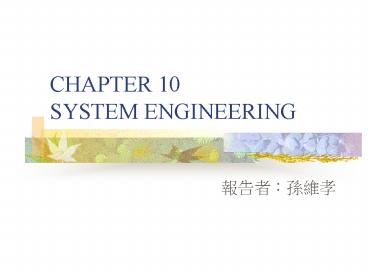CHAPTER 10 SYSTEM ENGINEERING - PowerPoint PPT Presentation
1 / 21
Title:
CHAPTER 10 SYSTEM ENGINEERING
Description:
WHAT : To understand the system. Determine the overall objective ... Test with unreal actor. Business process engineering. Information Strategy Planning ... – PowerPoint PPT presentation
Number of Views:90
Avg rating:3.0/5.0
Title: CHAPTER 10 SYSTEM ENGINEERING
1
CHAPTER 10SYSTEM ENGINEERING
- ??????
2
Outline
- Overview
- Systems
- System engineering hierarchy
- Business process engineering
- Product engineering
- Requirements engineering
- System modeling
3
Overview
- WHAT To understand the system
- Determine the overall objective
- Identify the system elements role
- Create operational requirements
- WHO System engineer
- Work with the customer, future users, and other
stakeholders - WHY To fit the system
4
Overview(cont.)
- PRODUCT Effective representation
- Prototype
- Specification
- Symbolic model
5
Systems
- Software-centric
- Hierarchy
- Top-down
- Button-up
- Complex system
- A system
- A macro-element of bigger system
6
Computer-based systems
- Software
- Hardware
- People
- Database
- Documentation
- Procedures
7
System engineering hierarchy
8
System modeling
- Define the processes that serve the needs of the
view under consideration - Represent the behavior of the processes and the
assumptions on which the behavior is based - Explicitly define the exogenous and endogenous
input to the model - Represent all linkages (including output) that
will enable the engineer to better understand the
view
9
System modeling restraining factors
- Assumptions
- Simplifications
- Limitations
- Constraints
- Preferences
10
System simulation
- Reactive system
- Test with unreal actor
11
Business process engineering
12
Business process engineering (cont.)
- BPE architecture
- Data architecture
- Applications architecture
- Technology infrastructure
13
Product engineering
14
Requirements engineering
- Requirements elicitation
- To know what the customer wants
- Why hard?
- Problems of scope
- Problems of understanding
- Problems of volatility
- Steps
- Product
- A statement of need and feasibility
- A bounded statement of scope
- A list of customers, users, and other
stakeholders - A description of systems technical environment
- A list of requirements and constraints
- A set of usage scenarios
- Prototypes
- Define the technical environment
- Identify domain constraints
- Solicit participation from many people
- Identify ambiguous requirements
- Create usage scenarios
15
Requirements engineering (cont.)
- Requirements analysis and negotiation
- Analysis
- Consistent?
- Proper?
- Necessary?
- Bounded and unambiguous?
- Attribution?
- Achievable?
- Testable?
- Negotiation
16
Requirements engineering (cont.)
- Requirements specification
- Any type
- System modeling
- Take a look
- Requirements validation
- ?
- Requirements management
- Traceability table
17
Traceability table
- Feature traceability table
- Source traceability table
- Dependency traceability table
- Subsystem traceability table
- Interface traceability table
18
System modeling
- System modeling template
19
System modeling (cont.)
- System context diagram
Main system
20
System modeling
- System flow diagram
Part
Part
Part
Part
Part
Part
Part
Part
Part
Part
Part
21
Summary
- Analysis system from top to down, from large to
tiny - Look from variant direction
- Make everything clear before do it
- Leave documentation































